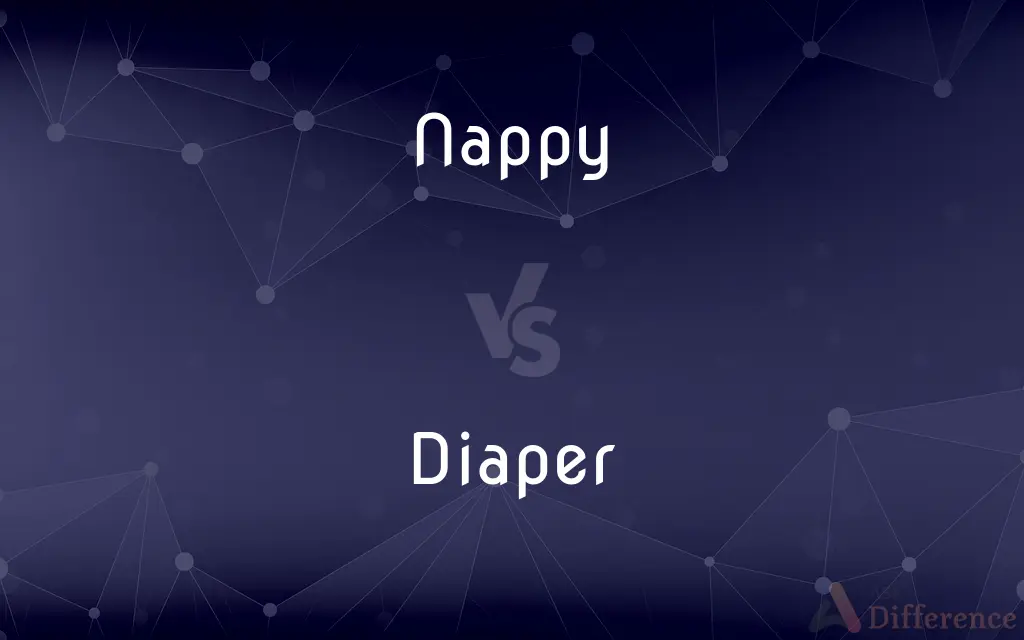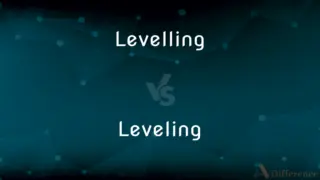Nappy vs. Diaper — What's the Difference?
By Maham Liaqat & Urooj Arif — Updated on March 17, 2024
Nappy is the British English term for a baby's absorbent undergarment, while diaper is the American English equivalent, both serving the same function.

Difference Between Nappy and Diaper
Table of Contents
ADVERTISEMENT
Key Differences
Nappy is used predominantly in British English to describe an absorbent garment worn by infants or those who lack control over their bladder and bowels. It is designed to be worn between the legs, fastened around the waist, and is capable of absorbing and containing waste. Whereas, diaper is the term used in American English for the same item, highlighting the geographical variation in English terminology for certain products.
The term "nappy" has a historical origin in the United Kingdom and is widely recognized and used across British Commonwealth countries. On the other hand, "diaper" originates from the American English language, illustrating how English vocabulary can diverge based on cultural and regional differences.
In terms of design and material, both nappies and diapers have evolved significantly over time, from cloth materials that require washing and reuse to disposable versions that offer convenience. However, the choice between cloth and disposable types is available under both terminologies, emphasizing functionality over linguistic differences.
Environmental concerns have led to innovations in both nappy and diaper designs, with both terms now encompassing biodegradable and eco-friendly options. This shift reflects a universal response to global environmental issues, transcending the linguistic divide.
Though the terminology differs, the cultural significance and societal attitudes towards nappies and diapers are largely similar, with both being essential items for early childhood care. This commonality underscores the shared experiences of parenthood across different linguistic communities.
ADVERTISEMENT
Comparison Chart
Geographic Usage
British English-speaking countries.
American English-speaking countries.
Origin
British English.
American English.
Material Options
Cloth and disposable.
Cloth and disposable.
Environmental Impact
Includes eco-friendly options.
Includes eco-friendly options.
Cultural Significance
Essential for early childhood care.
Essential for early childhood care.
Compare with Definitions
Nappy
Designed to contain urine and feces.
The nappy kept the baby dry through the night.
Diaper
Ensures hygiene and comfort for the baby.
A good diaper absorbs well and prevents leaks.
Nappy
Essential item for newborns and toddlers.
New parents often receive nappies as gifts at baby showers.
Diaper
Necessary for infant care and mobility.
Diapers are on the top of the list for baby essentials.
Nappy
Absorbent garment for infants, used in British English.
She packed an extra nappy for the baby before leaving.
Diaper
Absorbent garment for infants, used in American English.
She changed the baby's diaper in the restroom.
Nappy
Can be made of cloth or disposable material.
Many parents prefer cloth nappies for environmental reasons.
Diaper
Can also be made of cloth or disposable material.
Disposable diapers are convenient but contribute to landfill waste.
Nappy
Available in various sizes and designs.
The store had a wide selection of nappies with different patterns.
Diaper
Comes in various absorbencies for day and night use.
Nighttime diapers offer extra protection for uninterrupted sleep.
Nappy
Having a nap; fuzzy
A nappy carpet.
Diaper
A diaper /ˈdaɪpə(r)/ (American and Canadian English) or a nappy (Australian English, British English, and Hiberno-English) is a type of underwear that allows the wearer to urinate or defecate without using a toilet, by absorbing or containing waste products to prevent soiling of outer clothing or the external environment. When diapers become wet or soiled, they require changing, generally by a second person such as a parent or caregiver.
Nappy
Often Offensive Tightly curled or coiled. Used of hair.
Diaper
A folded piece of absorbent material, such as paper or cloth, that is placed between a baby's legs and fastened at the waist to contain excretions.
Nappy
A round, shallow cooking or serving dish with a flat bottom and sloping sides.
Diaper
A pattern composed of small, regularly repeated geometric motifs, usually diamonds or lozenges, used to decorate a surface.
Nappy
A diaper.
Diaper
A white cotton or linen fabric having such a pattern.
Nappy
An absorbent garment worn by a baby who does not yet have voluntary control of their bladder and bowels or by someone who is incontinent; a diaper.
The baby did a poo in her nappy.
Diaper
A piece of such fabric.
Nappy
A shallow, flat-bottomed earthenware or glass bowl with sloping sides.
Diaper
To put a diaper on.
Nappy
(obsolete) A kind of strong ale; nappy ale.
Diaper
To weave or decorate in a diaper pattern.
Nappy
(transitive) To put a nappy on.
The mother nappied the baby.
Diaper
A textile fabric having a diamond-shaped pattern formed by alternating directions of thread.
Nappy
Having a nap (of cloth etc.); downy; shaggy.
Diaper
A towel or napkin made from such fabric.
Nappy
Of hair: tightly curled or twisted; frizzy Afro]] textured hair
Diaper
The diamond pattern associated with diaper textiles.
Nappy
(rare) Inclined to sleep; sleepy.
Diaper
Surface decoration of any sort which consists of the constant repetition of one or more simple figures or units of design evenly spaced.
Nappy
(of a drink) Foamy; having a large head.
Diaper
To put diapers on someone.
Diapering a baby is something you have to learn fast.
Nappy
(of a horse) Nervous, excitable.
Diaper
To draw flowers or figures, as upon cloth.
Nappy
(Scotland) brittle
Diaper
Any textile fabric (esp. linen or cotton toweling) woven in diaper pattern. See 2.
Nappy
Inclined to sleep; sleepy; as, to feel nappy.
Diaper
Surface decoration of any sort which consists of the constant repetition of one or more simple figures or units of design evenly spaced.
Nappy
Tending to cause sleepiness; serving to make sleepy; strong; heady; as, nappy ale.
Diaper
A towel or napkin for wiping the hands, etc.
Let one attend him with a silver basin, . . . Another bear the ewer, the third a diaper.
Nappy
Having a nap or pile; downy; shaggy.
Diaper
An infant's breechcloth.
Nappy
A round earthen dish, with a flat bottom and sloping sides.
Diaper
To ornament with figures, etc., arranged in the pattern called diaper, as cloth in weaving.
Engarlanded and diaperedWith in wrought flowers.
Nappy
A diaper{4}.
Diaper
To put a diaper on (a child).
Nappy
Garment consisting of a folded cloth drawn up between the legs and fastened at the waist; worn by infants to catch excrement
Diaper
To draw flowers or figures, as upon cloth.
Nappy
In small tight curls
Diaper
Garment consisting of a folded cloth drawn up between the legs and fastened at the waist; worn by infants to catch excrement
Diaper
A fabric (usually cotton or linen) with a distinctive woven pattern of small repeated figures
Common Curiosities
Are nappies and diapers available in different sizes?
Yes, they come in various sizes to fit infants and toddlers at different stages of growth.
How often should a nappy or diaper be changed?
Both should be changed as soon as they are soiled, or every 2-3 hours, to prevent rash and discomfort.
Are cloth nappies better than disposable diapers?
The choice between cloth and disposable depends on personal preferences, convenience, and environmental considerations.
What is the main difference between a nappy and a diaper?
The main difference is regional terminology; "nappy" is used in British English, and "diaper" in American English.
Can adults use nappies or diapers?
Yes, there are adult versions for those with medical conditions or incontinence issues.
How have nappies and diapers changed over the years?
They have evolved from reusable cloth versions to include disposable options, with improvements in absorbency and comfort.
Do nappies and diapers have an environmental impact?
Yes, especially disposable types, which contribute to landfill waste, prompting the development of eco-friendly options.
Can nappies and diapers cause skin irritation?
Yes, especially if left on too long or if the baby has an allergy to certain materials.
Why might parents choose biodegradable nappies or diapers?
For environmental reasons, as they reduce landfill waste and are made from more sustainable materials.
Are there gender-specific nappies or diapers?
While most for both gender, some brands offer gender-specific designs with different absorbency zones.
Can nappies and diapers be used interchangeably?
Yes, in terms of function they are interchangeable, but the term used may depend on the speaker's geographical location.
How do you dispose of a disposable nappy or diaper?
They should be securely wrapped and thrown in the trash. Do not flush disposables due to risk of blockage.
Is there a difference in the material used for nappies and diapers?
No, both can be made from similar materials, including cloth and super absorbent polymers for disposables.
What innovations are being made in nappy and diaper technology?
Innovations include more eco-friendly materials, better fit designs, and enhanced absorbency without bulk.
What are some common features of modern nappies and diapers?
Features include wetness indicators, elastic waistbands, and breathable materials to prevent rash.
Share Your Discovery

Previous Comparison
Party vs. Celebration
Next Comparison
Levelling vs. LevelingAuthor Spotlight
Written by
Maham LiaqatCo-written by
Urooj ArifUrooj is a skilled content writer at Ask Difference, known for her exceptional ability to simplify complex topics into engaging and informative content. With a passion for research and a flair for clear, concise writing, she consistently delivers articles that resonate with our diverse audience.














































